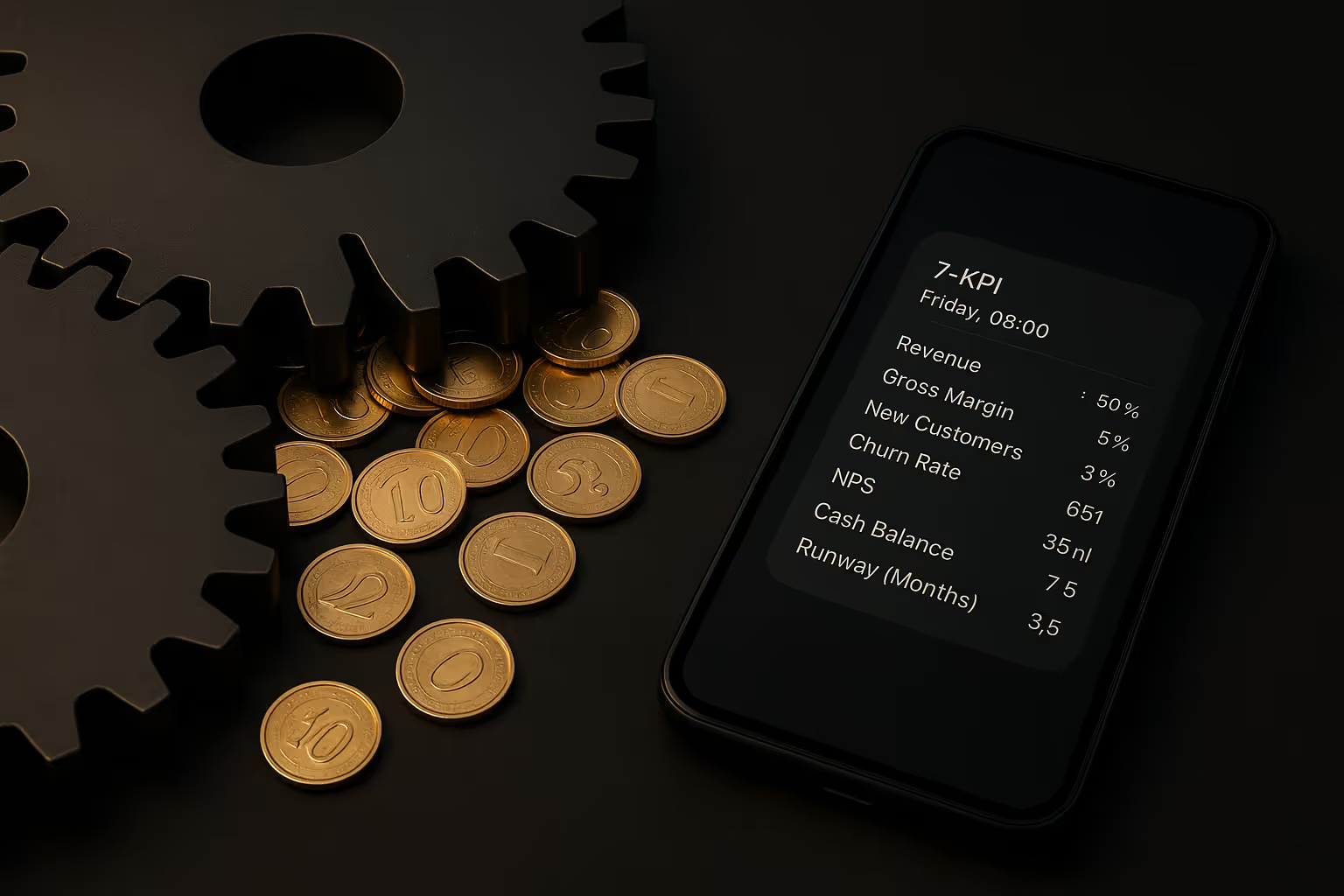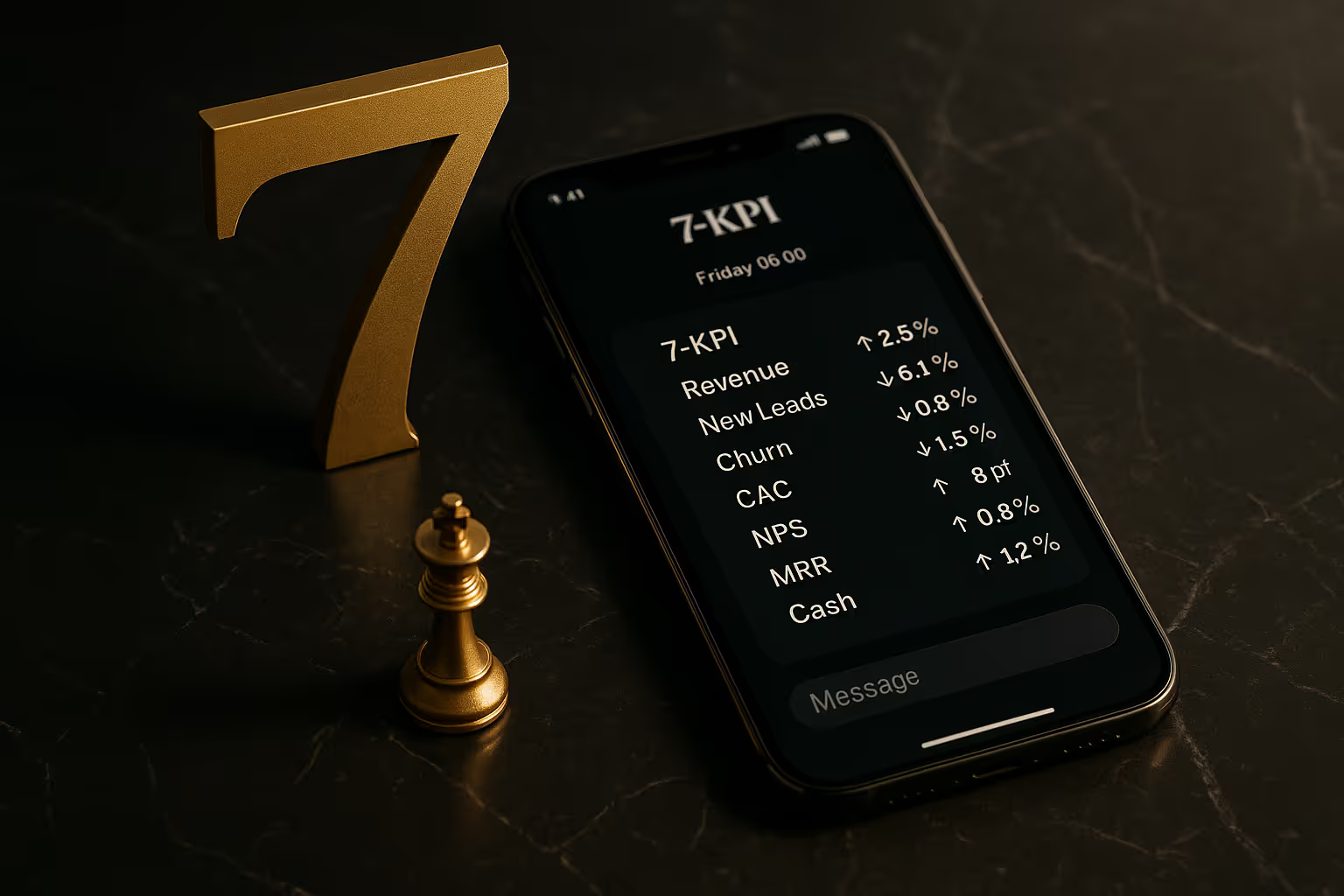Dashboard Fatigue: Symptoms, Costs & the SMS Alternative

“Dashboards were supposed to deliver clarity. Instead they drown us in data-rich, insight-poor clutter.”
Introduction
Charts, graphs, and RAG status widgets—what once felt empowering now just triggers yawns and glazed eyes. This is dashboard fatigue: a creeping form of KPI overload that smothers your ability to act. Gartner calls it the “data-rich, insight-poor” trap.
For the philosophy behind a strict seven-metric focus, see our primer on The 7-KPI Rule when you’re done here.
In this article, we’ll cover:
- What “dashboard fatigue” is and why it happens.
- The hidden costs it piles on your time, team morale, and bottom line.
- A lean reporting alternative – why more founders and CEOs are ditching sprawling dashboards for a focused 7-KPI weekly push system.
What Exactly Is Dashboard Fatigue?
Dashboard fatigue strikes when leaders face more data than their brains (or calendars) can handle. Finance, ops, marketing, HR—each team spins up its own analytics tool until the cockpit looks like an airport control room of screens.
Tell-tale symptoms include:
- You keep postponing metric reviews because they take forever.
- Weekly meetings have devolved into marathon slide-scroll sessions.
- Teams update dashboards out of obligation, not insight.
- Critical alerts pop up – but get lost in the noise before anyone acts.
If any of that sounds familiar, you’re already paying a hidden tax.
The Hidden Costs: Time, Morale, Money
As a founder or CEO, dashboard bloat isn’t just annoying—it’s costly in very real ways:
- Time drain: Too many dashboards steal hours. CEOs of mid-size companies spend 5+ hours per week just pulling and parsing data (Bain, 2024).
- Morale hit: When employees are bombarded by 30+ metrics, they feel about 38% less clear on what actually matters (Harvard Business Review).
- Revenue impact: [A McKinsey survey] found organizations that make decisions quickly are 2× more likely to make high-quality decisions and outperform slower peers.
For instance, a $25M ARR startup that reacts too slowly and misses just 1% of potential growth would be leaving about $250K on the table every year.
For a deeper dive into how sloppy metrics bleed profit, see - The Hidden Cost of Mis-Aligned Metrics (and How to Fix Them)
Why Dashboards Spiral Out of Control
- Tool creep – Every department adopts a new SaaS tool, each bringing yet another dashboard.
- Metric inflation – “If we can measure it, we must show it.” The urge to display everything means nothing gets pruned.
- Fear of missing data – Leaders worry that omitting any number could hide a risk, so the tabs keep piling up.
- No one pruning – Without a ruthless gardener to trim the metric jungle, dashboards turn into digital hoarding—screen space grows while clarity shrinks.
The Cognitive Science Behind “Seven”
There’s a reason the number seven keeps coming up as the magic number. Human working memory maxes out around 7±2 items at a time (Miller’s Law, 1956, confirmed by modern MRI studies). Push past 7–9 data points and decision quality plummets.
That’s why a lean KPI push system enforces a hard cap of seven weekly KPIs. It respects our biological limits, keeping the data digestible and actionable.
A Lean Alternative: The 7-KPI Weekly Update
Picture this: Friday, 8:00 AM. Instead of juggling five different dashboards, you get one concise summary on your phone:
W18 Summary• Revenue $612k ▲3 %
• CAC $186 ▼4 %
• Churn 1.9 % ▲0.2
• NPS 62 ▲1
• Cash $1.9M
• Gross Margin 63 % ▲2
• Pipeline $3.1M ▲5 %
In 30 seconds, you know exactly where to focus. No logins, no slide decks. This isn’t just dashboard reduction—it’s a replacement. A simple push (via SMS, Slack, etc.) delivers the vital facts once a week, and nothing more.
“But My Team Needs More Detail!”
Of course they do—and they can have it. Your finance, ops, and product teams might track dozens of granular metrics. Just enforce one rule: every sub-metric must roll up into one of the seven CEO-level KPIs.
This way, operational visibility stays intact in the trenches, while leadership remains shielded from the noise. Teams keep all their detailed numbers in their own tools; the CEO and stakeholders gets the distilled essence.
One KPI Always Matters Most
Keep in mind that at any given time, one of your seven metrics will matter more than the others. It depends on your company’s stage. For example:
- Early-stage SaaS: Weekly active users or activation rate.
- Scale-up: Gross margin.
- Mature manufacturer: Return on capital (ROIC).
By all means, shine extra light on that One Metric That Matters as your focus shifts each quarter. Just never expand your core list beyond seven key metrics.
Implementation Checklist
Ready to swap chaos for clarity? Here’s a quick playbook to implement a lean 7-KPI reporting system:
- Audit your dashboards. List every metric you currently review weekly across all dashboards.
- Select your seven North Star KPIs. Pick the seven metrics that truly reflect your business health (e.g. revenue, churn, cash runway, etc.).
- Assign owners. Put one person in charge of each KPI to drive data accuracy and accountability.
- Set a weekly cadence. Schedule a simple Friday morning push (e.g. an automated text or a 15-minute stand-up) to review the seven numbers.
- Archive the rest. Hide or archive all other metrics from the top-level report. Sub-metrics can live in team tools, but don’t surface them at the CEO level.
Follow this playbook and you’ll reclaim hours of focus, lift team morale, and start making decisions at the speed of opportunity.
Conclusion
Dashboard fatigue is real, costly, and completely fixable. The cure is a disciplined simplicity: replace the cluttered dashboard habit with a lean 7-metric weekly update. Savvy founders and CEOs are already swapping out noise for a tight signal, and the results speak for themselves—faster decisions, sharper focus, compounding growth.
time is money—spend it on growth, not on endless dashboards.

Keeping push reports short ensures they are read and acted upon. Focusing on 5–7 KPIs keeps recipients from drowning in data and directs attention to the numbers that truly drive performance.

Dashboard fatigue happens when the volume or complexity of data causes leaders and teams to disengage. Metrics lose visibility, and problems go unnoticed. This is often a sign that reporting needs to be simplified and pushed directly to decision-makers.

Push reporting removes the need to “pull” information from dashboards, saving time and ensuring key metrics are seen by everyone who matters. It’s proactive, timely, and more likely to drive action.



